| advanced |
TUTORIALS
- ARTS/125
- BCOM/231
- BCOM/275
- BIS/221
- BIS/221 T (NEW)
- BSA/310
- BSA/375 (NEW)
- BSA/376
- BSA/385 (NEW)
- BSA/515 (NEW)
- BSA/520 (NEW)
- BSA/525 (NEW)
- BSA/550 (NEW)
- BSCOM/100
- BUS/210
- BUS/212 (NEW)
- BUS/475 T (NEW)
- CIS/207 T (NEW)
- CIS/291
- CMGT/245 (NEW)
- CMGT/400 (NEW)
- CMGT/410 (NEW)
- CMGT/430
- CMGT/431 (NEW)
- CMGT/433 (NEW)
- CMGT/442 (NEW)
- CMGT/445 (NEW)
- CMGT/545 (NEW)
- CMGT/582 (NEW)
- CMGT/583 (NEW)
- COM/295
- COM/295 T (NEW)
- CSS/422 (NEW)
- CYB/110 (NEW)
- DBM/380
- ECO/365
- ECO/365 T (NEW)
- ECO/372
- ECO/372 T (NEW)
- ENG/220
- ENG/222
- ENG/223
- ENV/100
- ENV/410 (NEW)
- ETH/321
- ETH/321 T (NEW)
- FIN/370 T (NEW)
- HCS/405
- HCS/440
- HCS/451
- HCS/490
- HRM/300
- HRM/300 T (NEW)
- HRM/324
- HRM/498
- HUM/115 (NEW)
- HUM/186
- IT/200 (NEW)
- LDR/300
- LDR/300 T (NEW)
- LDRCB/535 (NEW)
- MBL/400 (NEW)
- MGT/312 T (NEW)
- MGT/362
- MGT/362 T (NEW)
- MGT/426
- MGT/498 (NEW)
- MGT/526 (NEW)
- MGTCB/526 (NEW)
- MKT/421
- MKT/421 T (NEW)
- MKT/441
- MTH/221
- NTC/255 (NEW)
- NTC/300 (NEW)
- NTC/302 (NEW)
- NTC/320
- NTC/324 (NEW)
- NTC/326
- NTC/328 (NEW)
- NTC/362 (NEW)
- NTC/409 (NEW)
- OPS/330 T (NEW)
- OPSCB/574 (NEW)
- ORGCB/535 (NEW)
- PHL/320 (NEW)
- PM/350 T (NEW)
- POS/355
- POS/408 (NEW)
- POS/408 T (NEW)
- POS/409
- PRG/211
- PRG/215
- PRG/218
- PRG/410 (NEW)
- PRG/420
- PRG/421
- PSY/300 (NEW)
- QNT/275
- SCI/220
- SOC/100
- SOC/110 (NEW)
DBM/384 Special Purpose Databases |
||
|
|
Or you may purchase tutorials by the Week below. | |
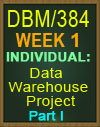 |
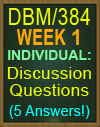 |
|
DBM/384 WEEK 1Includes Everything listed below for Week 1! A+ Work! Get the Entire Week of Tutorials for One Low Price!
Individual: Wk 1 - Data Warehouse Project, Part I Includes Option #1 with sql scripts and screenshots in both MS Word and MS Powerpoint Includes Option #2 with sql scripts and screenshots
Complete the following using Microsoft SQL Server 2016: Write SQL scripts in Microsoft SQL Server for OLTP that include:
Write and run a test script for Step Two. Save a screenshot of the results. Create a 6-page Technical Design Document that includes the SQL scripts in Microsoft SQL Server, test script, and screenshots. Compress the Technical Design Document that includes the SQL scripts in Microsoft SQL Server, test script, and screenshots into a ZIP file. Submit the ZIP file. Wk 1 Discussion - General vs. Special-Purpose DatabasesIncludes 5 Long Answers to Discussion Question Identify a general purpose and a special purpose database of your choice. Research and compare the general and special purpose databases that you have selected. Describe differences between the two databases.
|
||
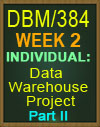 |
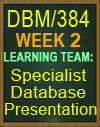 |
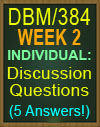 |
COMING SOON! |
||
DBM/384 WEEK 2
Includes Everything listed below for Week 2! Get the Entire Week of Tutorials for One Low Price!
Learning Team: Wk 2 Specialist Database Presentation Your team is tasked with creating an inventory price-tracking database for a company of your choosing. Complete the following steps in Microsoft® SQL Server® 2016:
Compress your DDL and DML scripts, query, test script, and results into a ZIP file. Submit the ZIP file.
Individual: Wk 2 - Data Warehouse Project, Part II Includes 5 Long Answers to Discussion Question Use the credit card database from the Week One Individual assignment, "Data Warehouse Project, Part I," as a basis for the creation of a data warehouse. Complete the following steps:
Create a 6-page Technical Design Document that includes a description of the five steps above and the results of completing the steps for the credit card data warehouse. Submit your Technical Design Document.
Wk 2 Discussion - OLTP and OLAP Organizations use database technology to store data that they collect, analyze, measure, and monitor as they conduct business. Data that is captured during transactional processes, as organizations sell products and services to their customers, is best structured in an OLTP database. Data that is used to analyze trends, key metrics, summary data, and for data mining is best stored in an OLAP database. Database designers need to understand the differences between OLTP and OLAP data and how to best design and build databases to support OLTP or OLAP requirements.
|
||
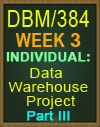 |
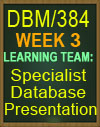 |
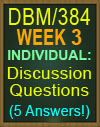 |
COMING SOON! |
||
DBM/384 Week 3Everything listed for this week is included in purchase!
Learning Team: Wk 3 Specialist Database Presentation Determine how spatial components can be used in the database your team created in Week Two. Create an Entity Relationship Diagram (ERD) with spatial components. Use Microsoft Visio to create this diagram. Include a minimum of two spatial components from the list below:
Add comments to your ERD explaining the components and their use. Submit your ERD. |
||
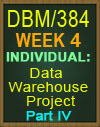 |
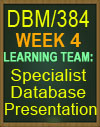 |
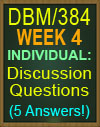 |
COMING SOON! |
||
DBM/384 Week 4Everything listed for this week is included in purchase!
Learning Team: Wk 4 Specialist Database PresentationComplete the following activities:
Add comments to your XML scripts explaining the benefits to your Learning Team company that a mobile database would provide the existing data system. Compress your XML scripts, comments, test script, and results into a ZIP file. Submit the ZIP file.
Individual: Wk 4 - Data Warehouse Project, Part IV Complete the following using Microsoft SQL Server 2016:
Create a 5-page Technical Design Document that includes the following topics:
Submit your Technical Design Document. Wk 4 Discussion - NoSQL Includes 5 Long Answers to Discussion Question A mid-sized financial services company is considering implementing a NoSQL database. From the perspective of an IT Manager in this financial services company, describe how NoSQL databases could be used in the organization. Under what circumstances might it be an appropriate implementation choice for a financial services business?
|
||
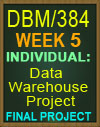 |
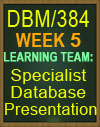 |
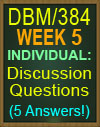 |
COMING SOON! |
||
DBM/384 Week 5
Everything listed for this week is included in purchase!
Learning Team: Wk 5 Specialist Database PresentationCreate a 1-page Technical Design Document, which describes the business use of the Learning Team company's database. Include scripts and Entity Relationship Diagrams (ERDs). Submit your document. Individual: Wk 5 - Data Warehouse Project Final Project Finalize the credit card data warehouse by completing the following steps using MicrosoftSQL Server 2016:
Complete the 6-page Technical Design Document that includes the SQL queries created for Week Five, the test script, and screenshots of the results. Construct a final 15-slide tutorial in Microsoft PowerPoint with speaker notes that addresses the following criteria:
Submit the Technical Design Document and the tutorial presentation.
Wk 5 Discussion - Strengths and Weaknesses of Info Retrieval Includes 5 Long Answers to Discussion Question Select a website from the Internet that provides information to its stakeholders; examples of websites to consider are SEC.gov or USA.gov. Describe the strengths and weaknesses of the information retrieval processes used on this website from an end-user perspective.
|
||

